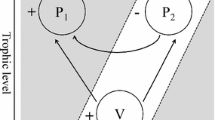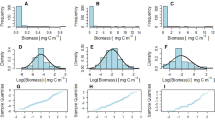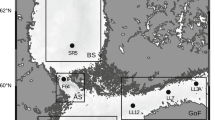Abstract
Ecological communities are shaped by a complex interplay between abiotic forcing, biotic regulation and demographic stochasticity. However, community dynamics modelers tend to focus on abiotic forcing overlooking biotic interactions, due to notorious challenges involved in modeling and quantifying inter-specific interactions, particularly for species-rich systems such as planktonic assemblages. Nevertheless, inclusive models with regard to the full range of plausible drivers are essential to characterizing and predicting community response to environmental changes. Here we develop a Bayesian model for identifying, from in-situ time series, the biotic, abiotic and stochastic factors underlying the dynamics of species-rich communities, focusing on the joint biomass dynamics of biologically meaningful groups. We parameterize a multivariate model of population co-variation with an explicit account for demographic stochasticity, density-dependent feedbacks, pairwise interactions, and abiotic stress mediated by changing environmental conditions and resource availability, and work out explicit formulae for partitioning the temporal variance of each group in its biotic, abiotic and stochastic components. We illustrate the methodology by analyzing the joint biomass dynamics of four major phytoplankton functional types namely, diatoms, dinoflagellates, coccolithophores and phytoflagellates at Station L4 in the Western English Channel using weekly biomass records and coincident measurements of environmental covariates describing water conditions and potentially limiting resources. Abiotic and biotic factors explain comparable amounts of temporal variance in log-biomass growth across functional types. Our results demonstrate that effective modelling of resource limitation and inter-specific interactions is critical for quantifying the relative importance of abiotic and biotic factors.
Similar content being viewed by others
Abbreviations
- AR model:
-
Autoregressive model
- BUGS:
-
Bayesian inference Using Gibbs Sampling
- LASSO:
-
Least Absolute Shrinkage and Selection Operator
- MCMC:
-
Markov Chain Monte Carlo
- PSU:
-
Practical Salinity Unit
- VAR model:
-
Vector Autoregressive model
References
Araújo, M.B. and M. Luoto. 2007. The importance of biotic interactions for modelling species distributions under climate change. Global Ecol. Biogeogr. 16:743–753.
Boalch, G.T., D.S. Harbour and E.I. Butler. 1978. Seasonal phytoplankton production in the western English Channel 1964–1974. J. Mar. Biol. Assoc. UK 58:943–953.
Brook, B.W. and C.J.A. Bradshaw. 2006. Strength of evidence for density dependence in abundance time series of 1198 species. Ecology 87:1445–1451.
Brooks, C. and C. Tasman. 2018. Density and biotic interactions modify the combined effects of global and local stressors. Oikos 127:1746–1758.
Clark, N.J., K. Wells and O. Lindberg 2018. Unravelling changing interspecific interactions across environmental gradients using Markov random fields.. Ecology 99:1277–1283.
Cooper, G.J. 2003. The Science of the Struggle for Existence. Cambridge University Press, Cambridge, UK.
Davis, A.J., J.H. Lawton, B. Shorrocks and L.S. Jenkinson. 1998a. Individualistic species responses invalidate simple physiological models of community dynamics under global environmental change.. J. Anim. Ecol. 67:600–612.
Davis, A., L.S. Jenkinson, J.H. Lawton, B. Shorrocks and S. Wood. 1998b. Making mistakes when predicting shifts in species range in response to global warming.. Nature 391:783–786.
De Baar, H.J.W. 1994. Von Liebig law of the minimum and plankton ecology (1899–1991). Prog. Oceanogr. 33:347–386.
Delean, S., B.W. Brook and C.J.A. Bradshaw. 2013. Ecologically realistic estimates of maximum population growth using informed Bayesian priors. Methods Ecol. Evol. 4:34–44.
Doney, S.C., 2006. Phytoplankton in a warmer world.. Nature 444:695–696.
Field, C.B., M.J. Behrenfeld, J.T. Randerson and P. Falkowski. 1998. Primary production of the biosphere: integrating terrestrial and oceanic components. Science 281:237–240.
Finkel, Z.V., A.J. Irwin and O. Schofield. 2004. Resource limitation alters the 3/4 size scaling of metabolic rates in phytoplankton. Mar. Ecol. Prog. Ser. 273:269–279.
Finkel, Z.V., 2001. Light absorption and size scaling of light-limited metabolism in marine diatoms.. Limnol. Oceanogr. 46:86–94.
Finkel, Z.V. and A.J. Irwin. 2000. Modelling size-dependent photosynthesis: light absorption and the allometric rule. J. Theor. Biol. 204:361–369.
Gelman, A., J.B. Carlin, H.S. Stern, D.B. Dunson, A. Vehtari and D.B. Rubin. 2013. Bayesian Data Analysis 3r Ed. Chapman and Hall, London, England.
George, E.I. and R.E. McCulloch. 1993. Variable selection via Gibbs sampling. J. Am. Stat. Assoc. 85:398–409.
Gilks, W.R., S. Richardson and D.J. Spiegelhalter (eds.), 1996. Markov Chain Monte Carlo in Practice. Chapman and Hall, London, UK.
Gilman, S.E., M.C. Urban, J. Tewksbury, G.W. Gilchrist and R.D. Holt. 2010. A framework for community interactions under climate change. Trends Ecol. Evol. 25:325–331.
Giraudeau, J. and G.W. Bailey. 1995. Spatia1 dynamics of cocco1ithophore communities during an upwelling event in the Southern Bengue1a system. Cont. Shelf Res. 15:1825–1852.
Götzenberger, L., F. de Bello, K.A. Bråthen, J. Davison, A. Dubuis, A. Guisan, et al. 2012. Ecological assembly rules in plant communities –approaches, patterns and prospects. Biol. Rev. 87:111–127.
Hampton, S.E., E.E. Holmes, L.P. Scheef, M.D. Scheuerell, S.L. Katz, D.E. Pendleton and E.J. Ward. 2013. Quantifying effects of abiotic and biotic drivers on community dynamics with multivariate autoregressive (MAR) models. Ecology 94:2663–2669.
Hampton, S.E., M.D. Scheuerell and D.E. Schindler. 2006. Coalescence in the Lake Washington story: interaction strengths in a planktonic food web. Limnol. Oceanogr. 51:2042–2051.
Hartman, S.E., M.C. Hartman, D.J. Hydes, D. Smythe-Wright, F. Gohin, F. and P. Lazure. 2014. The role of hydrographic parameters, measured from a ship of opportunity, in bloom formation of Karenia mikimotoi in the English Channel. J. Mar. Syst. 140:39–49.
Heikkinen, R.K., M. Luoto, R. Virkkala, R.G. Pearson and J.-H. Körber. 2007. Biotic interactions improve prediction of boreal bird distributions at macro-scales. Glob. Ecol. Biogeogr. 16:754–763.
Hoerl, A. E. and R. W. Kennard. 1970. Ridge regression: Biased estimation for nonorthogonal problems. Technometrics 12(1):55–67.
Holligan, P.M. and D.S. Harbour. 1977. The vertical distribution and succession of phytoplankton in the western English Channel in 1975 and 1976. J. Mar. Biol. Assoc. U.K. 57:1075–1093.
Irwin, A.J. and Z.V. Finkel. 2018. Phytoplankton functional types: a trait perspective. In: Kirchman, D.M. and Gasol, J.M. (eds), Microbial Ecology of the Ocean. Wiley. Chapter 11, pp. 435–465.
Ives, A.R., B. Dennis, K.L. Cottingham and S.R. Carpenter. 2003. Estimating community stability and ecological interactions from time-series data. Ecol. Monogr. 73:301–330.
Jeffreys, H., 1961. The Theory of Probability (3rd ed.). Oxford University Press, Oxford, UK
Kissling, W.D., C.F. Dormann, J. Groeneveld, T. Hickler, I. Kühn, G.J. McInerny, J.M. Montoya, C. Römermann, K. Schiffers, F.M. Schurr, A. Singer, J.-C. Svenning, E.Z. Niklaus, and R.B. O’Hara. 2012. Towards novel approaches to modelling biotic interactions in multispecies assemblages at large spatial extents. J. Biogeogr. 39:2163–2178.
Lande, R., S. Engen and B-E. Saether. 2003. Stochastic Population Dynamics in Ecology and Conservation. Oxford University Press, Oxford.
Lany, N.K., P.L. Zarnetske, T.C. Gouhier and B.A. Menge. 2017. Incorporating Context Dependency of Species Interactions in Species Distribution Models. Integr. Comparat. Biol. 57:159–167, https://doi.org/10.1093/icb/icx057.
Laws, E.A. 2013. Evaluation of in situ phytoplankton growth rates: A synthesis of data from varied approaches. Ann. Rev. Mar. Sci. 5:247–268.
Le Quéré, C., S.P. Harrison, P.I. Colin, E.T. Buitenhuis, et al. 2005. Ecosystem dynamics based on plankton functional types for global ocean biogeochemistry models. Glob. Change Biol. 11:2016–2040.
Litchman, E., C.A. Klausmeier, J.R. Miller, O.M. Schofield and P.G. Falkowksi. 2006. Multi-nutrient, multi-group model of present and future oceanic phytoplankton communities. Biogeosciences 3:585–606.
Loreau, M. and C. de Mazancourt. 2008. Species synchrony and its drivers: neutral and nonneutral community dynamics in fluctuating environments. Am. Nat. 172:E48–E6.
Lunn, D.J., A. Thomas, N. Best and D. Spiegelhalter. 2000. WinBUGS - A Bayesian modelling framework: Concepts, structure, and extensibility.. Stat. Comput. 10:325–337.
McCarthy, M. 2007. Bayesian Methods in Ecology. Cambridge University Press, New York.
Menden-Deuer, S. and E.J. Lessard. 2000. Carbon to volume relationships for dinoflagellates, diatoms, and other protest plankton. Limnol. Oceanogr. 45:569–579.
Mutshinda, C.M., Z.V. Finkel, C.E. Widdicombe and A.J. Irwin. 2017. Phytoplankton traits from long-term oceanographic time-series. Mar. Ecol. Prog. Ser. 576:11–25.
Mutshinda, C.M., Z.V. Finkel, C.E. Widdicombe and A.J. Irwin. 2016. Ecological equivalence of species within phytoplankton functional groups. Funct. Ecol. 30:1714–1722.
Mutshinda, C.M., Z.V. Finkel and A.J. Irwin. 2013. Which environmental factors control phytoplankton populations? A Bayesian variable selection approach. Ecol. Model. 269:1–8.
Mutshinda, C. M. and M. J. Sillanpää 2011. Bayesian shrinkage analysis of QTLs under shape-adaptive shrinkage priors, and accurate re-estimation of genetic effects.. Heredity 107:405–412.
Mutshinda, C.M. and M.J. Sillanpää. 2012. A decision rule for quantitative trait locus detection under the extended Bayesian LASSO model. Genetics 192:1483–1491.
Mutshinda, C.M., R.B. O’Hara and I.P. Woiwod. 2011. A multispecies perspective on ecological impacts of climatic forcing. J. Anim. Ecol. 80:101–107.
Mutshinda, C.M. 2010. Bayesian Analysis of Community dynamics. PhD thesis, University of Helsinki, Helsinki, Finland.
Mutshinda, C.M. and M.J. Sillanpää. 2010. Extended Bayesian LASSO for multiple quantitative trait loci mapping and unobserved phenotype prediction. Genetics 186:1067–1075.
Mutshinda, C.M., R.B. O’Hara and I.P. Woiwod. 2009. What drives community dynamics? Proc. R. Soc. London, Ser. B 276:2923–2929.
Mutshinda C.M. 2009. Cutting across discipline boundaries: Statistical prospects in disclosing and handling the workings of natural biodiversity. Intl. J. Biol. 1:101–103.
Nicholson, A.J. 1933. The balance of animal populations. J. Anim. Ecol. 2:131–178.
O’Hara R.B. and M.J. Sillanpää. 2009. A review of Bayesian variable selection methods: what, how and which? Bayesian Analysis 4:85–115.
Ovaskainen, O., J. Hottola and J. Siitonen. 2010. Modeling species co-occurrence by multivariate logistic regression generates new hypotheses on fungal interactions. Ecology 91:2514–2521.
Ovaskainen, O, G. Tikhonov, D. Dunson, V. Grøtan, S. Engen, B.-E. Sæther and N. Abrego. 2017. How are species interactions structured in species-rich communities? A new method for analysing time-series data. Proc. R. Soc. London, Ser. B 284:20170768.
Park, T. and G. Casella. 2008. The Bayesian LASSO. J. Amer. Stat. Assoc. 2008:103:681–686.
Plummer, M., et al. 2003. Jags: A program for analysis of Bayesian graphical models using gibbs sampling. In Proceedings of the 3rd international workshop on distributed statistical computing, volume 124. Vienna, Austria.
Pollock, L.J., R. Tingley, W.K. Morris, N. Golding, R.B. O’Hara, K.M. Parris, P.A. Vesk and M.A. McCarthy. 2014. Understanding co-occurrence by modelling species simultaneously with a Joint Species Distribution Model (JSDM). Methods Ecol. Evol. 5:397–406.
Porzig, E.L., N.E. Seavy, J.M. Eadie, D.L. Humple, G.R. Geupel and T. Gardali. 2016. Interspecific interactions, population variation, and environmental forcing in the context of the community. Ecosphere 7(6), e01349. 10.1002/ecs2.1349.
Saether, B.-E., J. Tufto, S. Engen, K. Jerstad, O.W. Rostad and J.E. Skátan. 2000. Population dynamical consequences of climate change for a small temperate songbird. Science 287:854–856.
Stachowicz, J.J. 2001. Mutualism, facilitation, and the structure of ecological communities. Bioscience 51:235–246.
Stan Development Team. 2018. Stan modelling language user’s guide and reference manual, version 2.18.0. http://mc-stan.org/.
Tibshirani, R. 1996. Regression shrinkage and selection via LASSO. J. Roy. Stat. Soc. B 58:267–288.
Thomas, A., R.B. O’Hara, U. Ligges and S. Sturtz. 2006. Making BUGS Open. R News 6:12–17.
van der Ploeg, R.R. and M. Kirkham. 1999. On the origin of the theory of mineral nutrition of plants and the law of the minimum. Soil Sci. Soc. Am. J. 63:1055–1062.
Widdicombe, C.E., D. Eloire, D. Harbour, R.P. Harris and P.J. Somerfield. 2010a. Long-term phytoplankton community dynamics in the Western English Channel.. J. Plankton Res. 32:643–655.
Widdicombe, C.E., D. Eloire, D. Harbour, R.P. Harris and P.J. Somerfield. 2010b. Time series of phytoplankton abundance and composition at station L4 in the English Channel from 1988 to 2009. PANGAEA, https://doi.org/10.1594/PANGAEA.754335, In supplement to: Widdicombe, C.E. et al. (2010) Long-term phytoplankton community dynamics in the Western English Channel. J. Plankton Res. 32:643–655, https://doi.org/10.1093/plankt/fbp127.
Author information
Authors and Affiliations
Corresponding author
Electronic supplementary material
Rights and permissions
About this article
Cite this article
Mutshinda, C.M., Finkel, Z.V., Widdicombe, C.E. et al. Bayesian inference to partition determinants of community dynamics from observational time series. COMMUNITY ECOLOGY 20, 238–251 (2019). https://doi.org/10.1556/168.2019.20.3.4
Received:
Revised:
Accepted:
Published:
Issue Date:
DOI: https://doi.org/10.1556/168.2019.20.3.4




